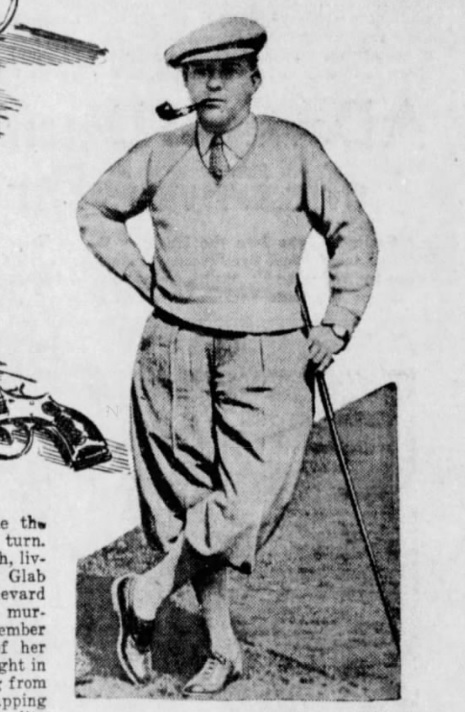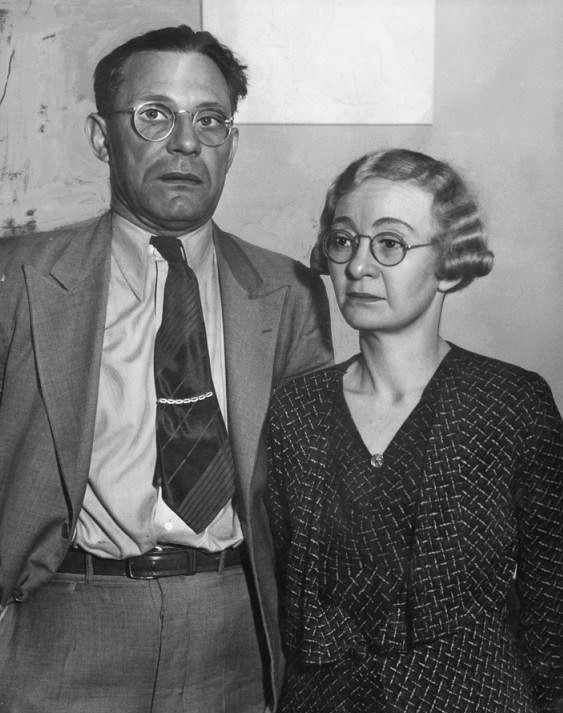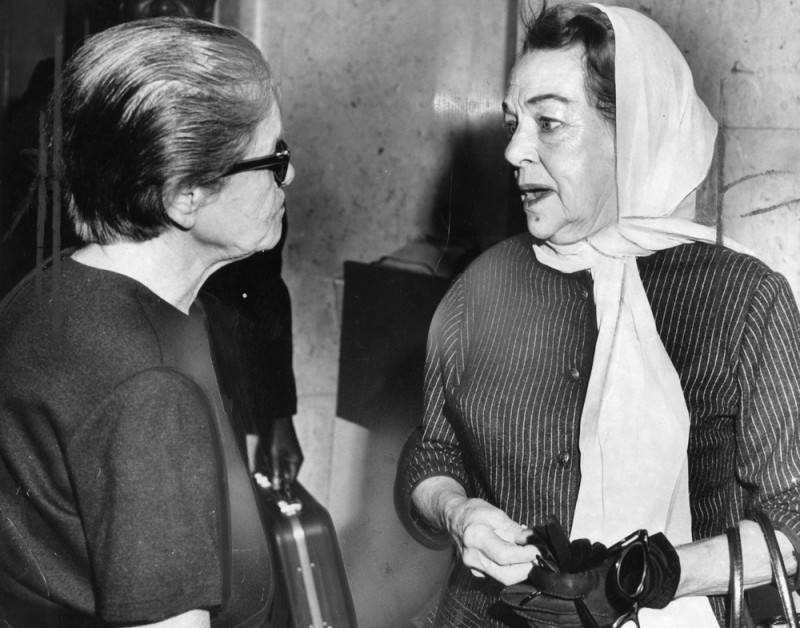By Don Chaddock, Inside CDCR editor
Office of Public and Employee Communications
Hazel Belford-Glab found herself the center of attention but not in the way she hoped. Her motion picture career had vanished and her prospects looked bleak. For the “two-gun” gal from Oklahoma, trouble was only a forgery away. This is the second part of a two-part installment on Belford-Glab. (Read the first part, link opens new tab.)
Another marriage proposal, another death
By the time she was 41, Hazel Belford-Glab’s career was non-existent, her funds were running low and she was desperate. Enter wealthy Los Angeles businessman Albert Llewellyn Cheney, a widower lost in grief.

Cheney and Belford-Glab traveled to Las Vegas March 13, 1935. They stayed in a hotel, expecting to wed the following day, according to the bride-to-be. Cheney didn’t make it through the night.
Without a marriage certificate, Belford-Glab realized she needed a way to get her hands on the money. She quickly got to work and rushed to make her claim.
“Filing of a will today naming Mrs. Hazel Glab (as) the chief heir disclosed a romance (that) ended when Cheney died unexpectedly,” reported the AP, March 22, 1935.
The will’s sudden appearance set off alarm bells for the family.
“At stake will be the vast fortune of the late Albert Cheney, 65-year-old Southern California millionaire, willed to her as his ‘future wife’ in his last testament,” reported the Bristol (Tennessee) Herald-Courier, May 11, 1935.
The purported will left Catherine Taylor, Cheney’s daughter, the house and its furnishings, but the remainder of his vast estate was to go to Belford-Glab.
“Written on hotel stationery in longhand in purple ink, and dated four months prior to his death, the will was signed by a business associate of Cheney in bright blue ink as witness,” the paper reported.
Doctor on call
Dr. Van Meter, of Las Vegas, was called to the hotel hours before Cheney’s death.
“Hotel attaches called me to attend one of their guests. I found Cheney intoxicated. On his head was a slight bruise. I ordered him to bed and after treating the bruise, I left,” Van Meter said. “About 9 p.m. of the same day I was called to the hotel again. When I arrived, Cheney was dead.”
Before he would sign a death certificate, the doctor insisted on speaking with other people familiar with Cheney. He called the man’s attorney, Donald Barker. The doctor was told the dead-man’s wife passed away about a year earlier, which is when he met Belford-Glab.
Cheney had been “drinking heavily” since his wife’s death, the attorney stated.
Belford-Glab claimed their relationship was genuine. “I met Mr. Cheney several months ago just shortly after the death of Mrs. Cheney. I went to his home with some friends of his and we immediately liked each other. Shortly after that he asked me to move into his home and I did. I have been living there for the past seven or eight months, and for the last six months, we have been planning to get married,” she told police. She had also taken over all of his business dealings and daily affairs.
Through deception, she was able to get close to her target. Belford-Glab whispered to the grieving man a tale of desperation.
Catherine Taylor, Cheney’s daughter, told a different version of events. She said during the party, Belford-Glab slipped into the house uninvited. Through deception, she was able to get close to her target. Belford-Glab whispered to the grieving man a tale of desperation, asking for a place to stay. He agreed to let her rent a room in one of his deceased wife’s apartment buildings. Slowly, her manipulation and control of Cheney took hold, landing her in his home and in his financial dealings.
Forgery conviction reopens 1928 murder case
The scrutiny around the $400,000 will proved the document was a forgery. Investigators said Belford-Glab forged the will over a genuine signature of Cheney’s and then persuaded accomplices Fred and Clara Steeger to sign it as witnesses. The Steegers also found themselves facing criminal charges. The scheme finally convicted Belford-Glab of a felony. The scam also brought down her friends, destroying their marriage and landing both behind bars.

Through the trial testimony and evidence, it was clear Belford-Glab used Fred Steeger and his association with Cheney to gain access to the grief-stricken millionaire, cultivate a relationship with him and get her hands on a signature.
Fred Steeger agreed to testify against Belford-Glab in exchange for a lighter sentence. He received six months in county jail and three years probation. The trial also resulted in legally severing the Steegers’ marriage. Prosecutors proving he had not legally divorced his first wife by the time of the second marriage ceremony. Because of this, they compelled him to testify against her as well.
Clara was sentenced to California Institution for Women for six months to five years for “preparing false evidence.”
According to court records, “Glab, through defendant Fred Steeger, contacted Albert L. Cheney, a reputed millionaire, resulting in Mrs. Glab and Cheney living together in apartments in the city of Los Angeles from some time in September of 1934 until March 12, 1935, when they went to Las Vegas, Nev., where Cheney died the next day. … The day after Cheney’s funeral Fred Steeger drove Mrs. Glab to a stationer’s store where she bought some ink and an ink eradicator, advising Steeger that she wanted to do something with a paper in her possession with Cheney’s signature upon it.
“In fact, in December, 1934, she had told Steeger that she had Cheney’s signature upon a piece of paper, blank except for some numerals on the left–hand side. After (using the) ink eradicator, it was testified by Steeger, Mrs. Glab wrote a will on the sheet of paper above Cheney’s signature and the two Steegers then signed it as witnesses. This purported will was offered for probate in the Los Angeles county superior court and all three defendants there testified as to its validity – that it was written by Mrs. Glab at Cheney’s request and witnessed by the Steegers, also at his request. Testimony of a handwriting expert (showed the) will was written on the paper after Cheney signed it and after certain numerals had been eradicated.”
Given the depth of the deception, investigators cracked open their records and reopened the investigation into the 1928 murder of John Glab. This time, ex-policeman W.R. McIntyre didn’t protect his former flame.
“McIntyre told the grand jury that Mrs. Glab and her husband quarreled, the latter threatening to leaver her and (rewrite his) will (to give) his fortune to his first wife,” according to the AP, Jan. 13, 1936. “The murder indictment today charged that she shot Glab in the front yard of her home in 1928.”
Murderess serves time at CIW
For weeks in 1936, the Glab murder trial garnered ink across the country, again putting Hazel Glab in the spotlight.
A jury found her guilty of second-degree murder, carrying a sentence of five-years-to-life imprisonment. She was sent to the California Institution for Women at Tehachapi on a 1-to-14-year sentence for forging the Cheney will in addition to her murder sentence.
(She) has many sterling qualities. But her outstanding virtue is ambition. That’s why Hazel is in prison for murder and forgery.
Albuquerque Journal, May 24, 1936
“Mrs. Hazel Belford Poole Garland Glab, 38, … has many sterling qualities. She is social to a degree, considerate of people, of great resourcefulness, a passable movie actress and an expert markswoman,” reported the Albuquerque Journal, May 24, 1936. “But her outstanding virtue is … ambition. That’s why Hazel is in prison for murder and forgery.”
She won parole five years later but that wasn’t the end of her run-ins with the law or making headlines.
Claims she is victim of robbery
In 1957, Hazel Belford-Bridge, 63, resided in Studio City. For nearly two years, she had been divorced from her husband, western character actor Alfred M. Bridge. The two married in Las Vegas in 1946 and were granted divorce “on grounds of cruelty” in October 1955.
At her home in Studio City, she accused two men and a woman of “robbing her of $900 in cash and a three-carat $5,490 diamond ring. They have been ordered to stand trial. Mrs. Bridge was convicted of second-degree murder of her former husband in 1936,” reported the North Hollywood Valley Times, Sept. 26, 1957.
According to Mrs. Bridge, the trio beat her earlier in the day then returned later to rob her.
“She said (Jo Ann Thomas, 27,) broke her nose and tore out her hair as (Verner F. Nielsen, 46,) held her and (Charles L Campbell, 29,) watched,” the paper reported. “(The victim) testified the three came to her home on Sept. 9 and asked about a watch that Nielsen claimed to have lost at her home Aug. 24.”
After beating her, they left but returned later the same day. “The (victim) said she was locked outside the house by the trio, who … then took the cash and ring. Mrs. Bridge denied ever employing the Thomas woman.” Thomas was listed as a “cocktail waitress” in news reports at the time.
The case took a serious turn the following year when Hazel was accused of “pandering.”
According to the Los Angeles Public Library, “She was accused of soliciting Jo Ann Thomas, 27, for the purpose of prostitution. Police stated that Thomas worked at (Belford-Bridge’s) home for a period of two weeks and earned $500 from men brought there by (Belford-Bridge). She testified that she split her earnings fifty-fifty with (Belford-Bridge).”
Once again, she found herself behind bars, this time sentenced to six months in county jail, reported the Valley Times, July 9, 1958.
Lands in trouble with former cellmate
In 1960, she apparently reconnected with former California Institution for Women cellmate Ione Selman.
“Mrs. Hazel Bridge Garland, who served six years for murdering her husband, will be arraigned in Superior Court July 1 on a petty theft charge,” reported the Valley Times, June 20, 1960. “Mrs. Garland and Mrs. Selman, who also has a prior felony conviction, are accused of operating a shoplifting team in the Valley, Lakewood, Pasadena and Wilshire (areas).”

Selman was sent back to state prison “for up to five years,” reported the Valley Times, Sept. 5, 1960.
In 1965, she was accused of harassment by former cellmate Iona Selman.
Hazel Sue Belford-Glab Stoddard, claiming to be 61 but would have been 71 by this time, appeared in municipal court on a misdemeanor charge of “using obscene and threatening language over the telephone” against Selman.
The complaint was dropped and the two women “wound up shaking hands,” reported the Pasadena Independent, Oct. 29, 1965.
The argument between the two former offenders revolved around personal notes and papers Belford-Stoddard claims Selman was keeping from her.
Selman returned the papers with an agreement Belford-Stoddard would cease contacting her.
Another husband, another divorce
A week after the Selman case, Belford-Stoddard was back in the courtroom, this time for a divorce filed by her husband.
“Mrs. Stoddard appeared Thursday in Superior Court in a contested divorce trial with her fifth husband, Clyde Casey Stoddard, 60,” the paper reported.
“(Mr.) Stoddard charged fraud and told (the judge) he was unaware of her criminal past when he met (Hazel) last March 14. He added he did not find out about her past until July.”
They’d been married only five months so she agreed to “allow her husband to obtain an annulment” but managed to get some valuables out of the deal.
With her notes and personal papers in hand, she said she planned to turn her attentions to writing, focusing on a book about her life. She died before it was published.
Hazel Belford-Glab-Stoddard, 83, passed away Sept. 9, 1977.
Learn more about the department’s history (link opens new tab).
